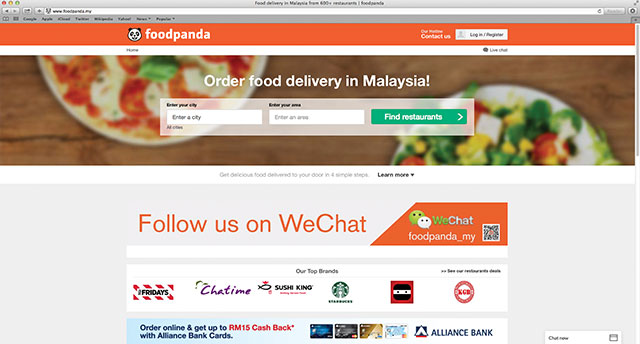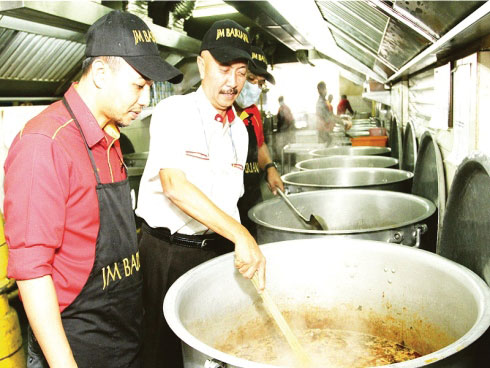A restaurant is not just four walls. If you give it some thought; there are countless possibilities to increase your brand presence and roll in more revenue than simply having queues outside the restaurant each night (although that is a perfect scenario!) Opening more branches definitely serves to get in more customers, in terms of location but there are other segments that await. Some examples that you may be familiar with:


What about replicating Jamie’s cuisine with bottled sauces he created?

Its food trucks are usually seen on carnival fairgrounds in Malaysia

Signature coffees bottled and available at convenience stores.

Bottled peri-peri sauces to the rescue when cravings strike

Coffee machines and pods for home brewing.

Host a party with catering platters. No hassle and delivered to the doorstep…

Chili’s Bar & Grill takes its business further with frozen pre-packed meals.

Thinking out of
the kitchen
These brands have taken steps to extend its presence out of structures and although some may require investment into Research & Development, it plays a role in strengthening their brand in terms of meeting more consumer demands resulting in enhanced loyalty and brand retention. Of course, in any undertaking of a new exercise, the planning should be comprehensive, making sure that you are able to finance the execution of the idea alongside adequate manpower and system to meet its promises to customers. Alternatively, for a shorter term plan to kickstart the new year, why not consider collaborating with food delivery solution providers?


Constantly updating its system
FOODPANDA; CONNECTING RESTAURANTS TO MORE CUSTOMERS
Striking orange insulated transport bags ferried across the city on motorcycles as Foodpanda’s delivery reps make the trip from the restaurant to deliver the food ordered by customers online or via its mobile app, within its promised 60 minutes. If one were to look at Asia, having food delivered to your doorstep was previously limited to pizzas or fast food because eating out meant traveling to the place and soaking in its atmosphere.

Founded in 2012, Foodpanda is a global food ordering marketplace where people can select a wide range of cuisines according to their fancy from around their neighbourhood. We caught up with Managing Director of Foodpanda Malaysia, Claudio Abitante who said that the company saw a 100% growth over the last 6 months; a positive showcase of both restaurateurs and diners opening up to food delivery. The busy city life has made eating out necessary where people tend to make pit stop near their workplace or home to pack food. In time, it is not uncommon for most to get bored.

Claudio during foodpanda
Malaysia’s launch
Foodpanda comes in as an aggregator of choices. Building a system for easy ordering using the Internet, it then set-up a call centre and gathered its riders into zones to pick-up and deliver food from the first 50 restaurants which took a chance on it. Today, it has more than 700 restaurants in Malaysia using its platform and Claudio says the company is looking towards hitting 1000 restaurants and lowering the delivery time to 40-45 minutes.

Collaborating with Foodpanda is hassle-free as a restaurant gets paid immediately upon dispatching an order. Foodpanda receives a percentage of commission from the restaurant each month, based on the amount of orders it received via the online food ordering platform. It is an extension of your marketing plan which cost very little as all the promotional exercises would be undertaken by Foodpanda through its website, social media, printed brochures as well as offering occasional discounts to customers while you, the restaurateur would still receive full payment. It aims to deliver as many items as possible, even items from 7-11 and groceries from Pressto while its most delicate deliverable is the frappe beverage.
Marketing Director, Sidney Ng raised a point worth a restaurant owner’s consideration; with stocks as your fixed cost and if they are perishable, why not maximise resources and improve exposure of your brand with Foodpanda; especially if you do provide takeaways. You will also minimise on the trouble with finding people to do delivery because when there are no orders, what will they do? Many restaurateurs have found it profitable and to quote Chef Tommes, owner of That Little Wine Bar in Penang and TV host of Chalk & Cheese, “new customers try my food at home and they come and dine here”. Its a win-win situation.
To find out more about working with Foodpanda in your country; visit www.foodpanda.com


GOING PLACES WITH ONE STAR PRODUCT
Many food businesses have captured the audience with just one or two signature items and such is the case with Malaysian brand JM Bariani House. How did the enterprise grab a bigger slice of the market with bariani alone? Speaking to Managing Director, Mr Zulkarnain Mustapa said the company actually began as a catering service where his retired parents would take small scale orders from companies by requests and cook from home. Bariani, believed to originate from Persia with the name “Baria” meant cooking rice and meat together in the same pot, was modified for local palates and became known as Jamilah Mustapa’s (JM) specialty.

As demands grew, the business moved into a shoplot to enable them to cook higher volumes. Without an intention to open a resturant, Mustapa and his wife put out a few tables on the walkway for customers to dine-in buffet style on non-catering days. However, fans found it hard to access a platter of spice-imbued rice anytime as the shop would be closed during preparation for catering. In time to come, JM Bariani would become a full-fledged restaurant but still maintaining its core in catering service.

Mr Zulkarnain
on-site to
monitor the
cooking of
Bariani
To maintain the quality across all its 18 outlets, a centralised kitchen is set up where food is still traditionally cooked with huge aluminium pots and gas stoves with plenty of manual stirring. Mr Zulkarnain tells us that the kitchen used to be able to do customised menu but they made a decision to only sell the Bariani and carve its niche in the market. Through trial and error, its chef has come up with the accurate equations thereby creating a fool-proof system where each gram of ingredient and step is accounted for. Therefore, if a customer needed bariani for 500 pax in 3 hours, it can be delivered because the kitchen has ready stock and is moulded to the preparation of bariani.

Signing of business plans
BRANCHING OUT FROM 18 OUTLETS
Although franchising offers limitless expansion possibilities, Mr Zulkarnain and his brothers who comanage the enterprise, prefers to keep it to about 20 outlets so that the brand stays consistent. Not one to rest on their laurels, the family-helmed business is looking to kiosk style operations of its bariani thus offering opportunity for smaller scale start-ups. The prototype of the kiosk is ready and service of food would be via rethermalisation. Zulkarnain recognises the importance of technology and has already adopted the cook-chill method which he says would be able to bring the product to wider coverage such as petrol stations, malls and overseas. “Although I love the old time methods, we cannot go far in today’s landscape without technology”, he said.
Banking on advancements, the company is in the midst of opening shop in Medan, Indonesia with a central kitchen to replicate the recipes and hopes to open 4-5 outlets there in time to come. In the pipeline is also a new JM Cafe positioned to offer customers other delicacies as his parents are still active and love to cook. As JM Bariani already a household name, the family felt that a better way to create excitement is through a different concept and menu to appeal to a wider market segment. On a smaller scale and to provide value to its customers, one can call for home delivery services within a 5 kilometre radius of selected outlets.
JM Bariani is an example of sustainable business management by staying focused on its unique cuisine and diversifying it in many ways out of the four walls.
For enquiries on business opportunities, visit www.jmbariani.com
![]()










